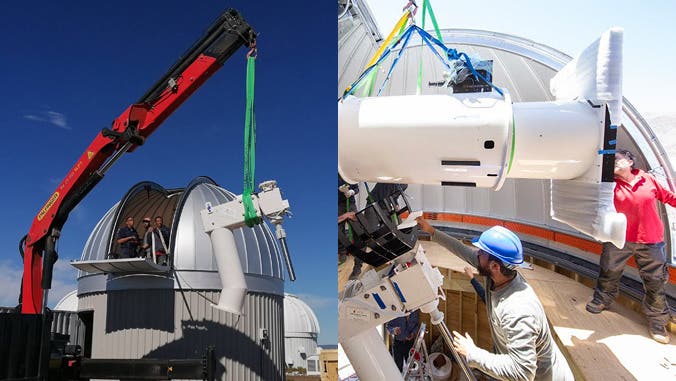Just Look Up: New asteroid tracking system can monitor entire sky
A state-of-the-art asteroid alert system can scan the entire dark sky every 24 hours for dangerous bodies that could plummet toward Earth.

[Jan 30, 2022: Roy Gal, University of Hawaii]
Left: Sutherland ATLAS station during construction in South Africa. Credit: Willie Koorts (SAAO) Right: Chilean engineers and astronomers installing the ATLAS telescope at El Sauce Observatory. (CREDIT: University of Hawaii)
A state-of-the-art asteroid alert system operated by the University of Hawaiʻi Institute for Astronomy (IfA) can now scan the entire dark sky every 24 hours for dangerous bodies that could plummet toward Earth.
The NASA-funded Asteroid Terrestrial-impact Last Alert System (ATLAS) has expanded its reach to the southern hemisphere, from two existing northern-hemisphere telescopes on Haleakalā and Maunaloa. Construction is now complete and operations are underway on two additional telescopes in South Africa and Chile.
“An asteroid that hits the Earth can come at any time from any direction, so ATLAS is now all the sky, all the time,” said John Tonry, IfA professor and ATLAS principal investigator.
The new telescopes are located at Sutherland Observing Station in South Africa and El Sauce Observatory in Chile. These locations were selected not only for their access to the southern part of the sky but also their time difference from Hawaiʻi—they are able to observe at night when it is daytime in Hawaiʻi. The four-telescope ATLAS system is now the first survey for hazardous asteroids capable of monitoring the entire dark sky every 24 hours. The modest-sized telescopes can image a chunk of sky 100 times larger than the full moon in a single exposure.


Telescope unit on Haleakalā, Maui. (Left image), ATLAS telescope on Maunaloa (Right image)
Related Stories
The ATLAS system can provide one day’s warning for a 20-meter diameter asteroid, capable of city-level destruction. Since larger asteroids can be detected further away, ATLAS can provide up to three weeks’ warning for a 100-meter asteroid, capable of wide regional devastation. An asteroid that large could produce 10 times the destruction of the recent Hunga Tonga volcano eruption if it were to strike the Earth.
UH developed the first two ATLAS telescopes in Hawaiʻi under a 2013 grant from NASA’s Near-Earth Objects Observations Program, now part of the Planetary Defense Coordination Office. The two facilities, on Haleakalā and Maunaloa, became fully operational in 2017.
First light and first discovery in southern hemisphere
After several years of successful operation in Hawaiʻi, IfA proposed for additional NASA funds to build two more telescopes in the southern hemisphere. IfA sought partners to host these telescopes, and selected the South African Astronomical Observatory (SAAO) in South Africa and a multi-institutional collaboration in Chile. The ATLAS presence augments already substantial astronomical capability in both countries.
Despite delays due to COVID-19 travel restrictions and supply-chain complications, the UH ATLAS team remotely supervised the assembly of the ATLAS telescopes in coordination with international collaborators in South Africa and Chile. In South Africa, the construction effort was led by the SAAO, and in Chile the team consisted of multiple partners, including the Millennium Institute for Astrophysics and Obstech, which operates the private El Sauce Observatory.
On January 22, ATLAS-Sutherland in South Africa discovered its first near-Earth object (NEO), 2022 BK, a 100-meter asteroid that currently poses no threat to Earth. To date, the ATLAS system has discovered more than 700 near-Earth asteroids and 66 comets, including detection of 2019 MO and observations of 2018 LA, two very small asteroids that actually struck the Earth. The system is specially designed to detect objects that approach very close to Earth—closer than the distance to the Moon, about 240,000 miles or 384,000 kilometers away.
The new ATLAS telescopes join existing ground-based surveys as well as other next-generation ground-based NEO detection systems in the works. According to Larry Denneau, IfA astronomer and ATLAS co-principal investigator, “Fortunately, NEO-hunting is a cooperative global effort, and the enhanced ATLAS complements the existing ground-based NEO search programs, namely UH’s own Pan-STARRS and the Catalina Sky Survey in Tucson, Arizona. All these systems have different specialties, and together they are working to keep us safe from hazardous asteroids that could strike anywhere from days to decades into the future.”
This program is an example of UH Mānoa’s goal of Excellence in Research: Advancing the Research and Creative Work Enterprise (PDF), one of four goals identified in the 2015–25 Strategic Plan (PDF), updated in December 2020.
Note: Materials provided above by University of Hawaii. Content may be edited for style and length.
Like these kind of feel good stories? Get the Brighter Side of News' newsletter.
Tags: #New_Innovations, #Astronomy, #Space, #Telescopes, #Asteroids, #NASA, #Earth, #Technology, #Science, #Research, #The_Brighter_Side_of_News
Joseph Shavit
Head Science News Writer | Communicating Innovation & Discovery
Based in Los Angeles, Joseph Shavit is an accomplished science journalist, head science news writer and co-founder at The Brighter Side of News, where he translates cutting-edge discoveries into compelling stories for a broad audience. With a strong background spanning science, business, product management, media leadership, and entrepreneurship, Joseph brings a unique perspective to science communication. His expertise allows him to uncover the intersection of technological advancements and market potential, shedding light on how groundbreaking research evolves into transformative products and industries.



